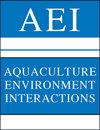水产养殖海景中的人工栖息地和生物污损物种分布
IF 2.5
2区 农林科学
Q2 FISHERIES
引用次数: 8
摘要
全球海洋人工栖息地的激增正在迅速改变海岸线的物理结构,对海景尺度上的物理、化学和生态过程产生连锁反应。人们对与水产养殖相关的海洋扩张的生态后果知之甚少,尽管这些悬浮结构特别容易产生生物淤积,这可能会影响其周围的工业和海景。我们描述了10个生物污损类群的海景尺度空间和时间分布模式,这些模式与新西兰最大水产养殖区Perna canaliculus贻贝养殖场的存在和距离有关。10个分类群中有7个在农场的覆盖率明显高于整个地区的自然栖息地。这7个分类群中有4个分类群的覆盖率随着距离最近的农场的距离呈指数级下降,其中包括备受关注的害虫Mytilus galloprovincialis和裙带菜,而一些分类群则不存在于自然栖息地(如海鞘Ciona robusta)。相比之下,一些机会性大型藻类物种,如鲁欣盖枝藻和梨形Pylaiella littoralis,已经在广阔的自然栖息地定居。我们的研究结果表明,生物淤积是贻贝养殖场的一个持久问题,养殖场结构可能成为传播潜在海洋害虫的蓄水池或“垫脚石”。这些分布和扩散模式可以为专注于空间管理策略的综合害虫管理工作提供信息,例如农场连接中的“防火带”、避开害虫热点和农场休耕。本文章由计算机程序翻译,如有差异,请以英文原文为准。
Artificial habitat and biofouling species distributions in an aquaculture seascape
The global proliferation of marine artificial habitats is rapidly altering the physical structure of coastlines, with knock-on effects on physical, chemical, and ecological processes at seascape scales. Ecological consequences of maritime sprawl associated with aquaculture are poorly understood, despite the fact that these suspended structures are particularly prone to biofouling, which can affect the industry and seascape around it. We characterised seascape-scale spatial and temporal distribution patterns of 10 biofouling taxa in relation to the presence and distance to Perna canaliculus mussel farms in New Zealand’s largest aquaculture region. Seven of 10 taxa had significantly higher cover on farms than in natural habitats throughout the region. The cover of 4 of those 7 taxa, including the high-profile pests Mytilus galloprovincialis and Undaria pinnatifida, exponentially decreased with distance from the nearest farm, while some taxa were absent from natural habitats (e.g. the ascidian Ciona robusta). In contrast, several opportunistic macroalgal species, such as Cladophora ruchingeri and Pylaiella littoralis, had colonised extensive areas of natural habitat. Our results suggest that biofouling is a persistent issue on mussel farms and that farm structures may act as reservoirs or ‘stepping stones’ for the dispersal of potential marine pests. These distributional and dispersal patterns can inform integrated pest management efforts focusing on spatial management strategies, such as ‘firebreaks’ in farm connectivity, avoidance of pest hotspots, and farm fallowing.
求助全文
通过发布文献求助,成功后即可免费获取论文全文。
去求助
来源期刊

Aquaculture Environment Interactions
FISHERIES-MARINE & FRESHWATER BIOLOGY
CiteScore
4.90
自引率
13.60%
发文量
15
审稿时长
>12 weeks
期刊介绍:
AEI presents rigorously refereed and carefully selected Research Articles, Reviews and Notes, as well as Comments/Reply Comments (for details see MEPS 228:1), Theme Sections and Opinion Pieces. For details consult the Guidelines for Authors. Papers may be concerned with interactions between aquaculture and the environment from local to ecosystem scales, at all levels of organisation and investigation. Areas covered include:
-Pollution and nutrient inputs; bio-accumulation and impacts of chemical compounds used in aquaculture.
-Effects on benthic and pelagic assemblages or processes that are related to aquaculture activities.
-Interactions of wild fauna (invertebrates, fishes, birds, mammals) with aquaculture activities; genetic impacts on wild populations.
-Parasite and pathogen interactions between farmed and wild stocks.
-Comparisons of the environmental effects of traditional and organic aquaculture.
-Introductions of alien species; escape and intentional releases (seeding) of cultured organisms into the wild.
-Effects of capture-based aquaculture (ranching).
-Interactions of aquaculture installations with biofouling organisms and consequences of biofouling control measures.
-Integrated multi-trophic aquaculture; comparisons of re-circulation and ‘open’ systems.
-Effects of climate change and environmental variability on aquaculture activities.
-Modelling of aquaculture–environment interactions; assessment of carrying capacity.
-Interactions between aquaculture and other industries (e.g. tourism, fisheries, transport).
-Policy and practice of aquaculture regulation directed towards environmental management; site selection, spatial planning, Integrated Coastal Zone Management, and eco-ethics.
 求助内容:
求助内容: 应助结果提醒方式:
应助结果提醒方式:


